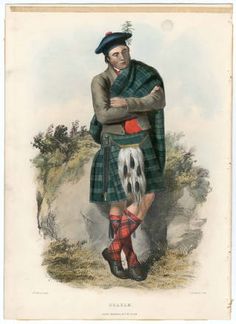
Most of us don't know the difference between plaid and tartan. Tartan refers to the unique cloth patterns which distinguish one Scottish clan or geographical region from another. By the original Scottish definition, a "plaid" was a Celtic kilt or blanket which served as an outer layer to battle the Highland elements.

Plaid, as we know it, was later appropriated by British and American manufacturers, who created patterned fabric which resembled tartan. Written records from 1538 place the fabric in high esteem amongst royalty including King James V, who gifted his wife with several bolts of the material.

Tartan was actually literally forbidden in Britain during the 18th century. The fabric's rebel uniform association with the Scottish Rebellion of 1745 against the union of Scotland and England, making tartan prohibited in the country for nearly half a century under the Dress Act. The print didn't really resurface again until 1782, when plaid became legal, and it became in vogue to wear plaid gowns to formal occasions.

Tartan is a pattern consisting of criss-crossed horizontal and vertical bands in multiple colours. Tartans originated in woven wool, but now they are made in many other materials. Scottish kilts almost always have tartan patterns. Tartan is often called plaid in North America, but in Scotland, a plaid is a tartan cloth slung over the shoulder as a kilt accessory, or a plain ordinary blanket such as one would have on a bed.

Tartan is made with alternating bands of coloured (pre-dyed) threads woven as both warp and weft at right angles to each other. The weft is woven in a simple twill, two over — two under the warp, advancing one thread at each pass. This forms visible diagonal lines where different colours cross, which give the appearance of new colours blended from the original ones. The resulting blocks of colour repeat vertically and horizontally in a distinctive pattern of squares and lines known as a sett.

While they often came in the same colors, “plaids” were actually heavy traveling cloaks worn to ward off the bitter cold of the Scottish winters. Plaid only replaced tartan once the patterns became popular with British and American textile manufacturers who would recreate fabrics that looked like tartans, but without centuries of symbolic meaning embedded in their clothing.

“If you lived in a remote land, you would buy your woven cloth from the same weaver,” the Scottish Tartans Authority’s Brian Wilton tells Rick Paulas for Pacific Standard. “And the weaver would not be reproducing a choice of patterns, but a standard pattern using the colors available to him, many of which were vegetable dyes.”
Tartan goes back at least 3,000 years, with the oldest example of the fabric found buried with the remains of “the Cherchen Man,” a mummy of Caucasian descent found buried in the sands of the western Chinese desert, according to the Tartans Authority.

During the 18th century, tartan was co-opted from Scottish family symbol to military uniform under James Francis Edward Stuart’s 1714 rebellion against the English monarchy. At the time, a pattern now known as “Black Watch Plaid” became associated with the Royal Highland Regiment, a Scottish military force that remained the pride of the United Kingdom’s army until it was disbanded in 2003.

In recent years, however, plaid has had such a strong resurgence that in some places you would be hard-pressed to look around and not see at least one person wearing checked plaid. Hipsters are far from the only subculture to make plaid their uniform: some Los Angeles street gangs identify their allegiances with plaid clothing, while the Beach Boys made plaid Pendleton shirts the symbol of 1960s surf rock. Whatever the color and context, it seems like plaid is one pattern that may never go out of style.

Until the middle of the nineteenth century, the highland tartans were only associated with either regions or districts, rather than any specific Scottish clan. This was because like other materials, tartan designs were produced by local weavers for local tastes and would usually only use the natural dyes available in that area, as chemical dye production was non-existent and transportation of other dye materials across long distances was prohibitively expensive.

Travellers to Scotland over the past several hundred years have noted the Tartan worn by its inhabitants. These records refer to it as ‘mottled’, ‘marled’ and ‘sundrie coloured’, but perhaps the best description comes from the Gaelic word breacan, meaning chequered.

The patterns were simply different regional checked-cloth patterns, chosen by the wearer's preference – in the same way as people nowadays choose what colours and patterns they like in their clothing, without particular reference to propriety.

Today the confusion of the past has gained some semblance of order as tartans now require registration in the Registers at Lyon Court.
Several variations of one tartan may be worn and these tend to take their name from the purpose for which they were intended.
Clan tartans – for general use by the clans people.
Dress tartans – originally worn by the women of the clan, generally with a white background and lighter-coloured patterns.

Mourning tartans – generally of black and white.
Hunting tartans – dark in colour and worn for sport, especially suitable when a clan possessed a brightly coloured tartan, making it unsuitable for hunting.
Chiefs’ tartans – for the personal use of the chief and his immediate family.
Tartan has now gained international popularity with people selecting and sporting a design of his or her fancy. A word of warning however, the Royal tartan is for the exclusive use of the royal family and woe betide anyone who dares to break with this tradition!

The Dress Act of 1746 attempted to bring the warrior clans under government control by banning the tartan and other aspects of Gaelic culture. When the law was repealed in 1782, it was no longer ordinary Highland dress, but was adopted instead as the symbolic national dress of Scotland.


